| |
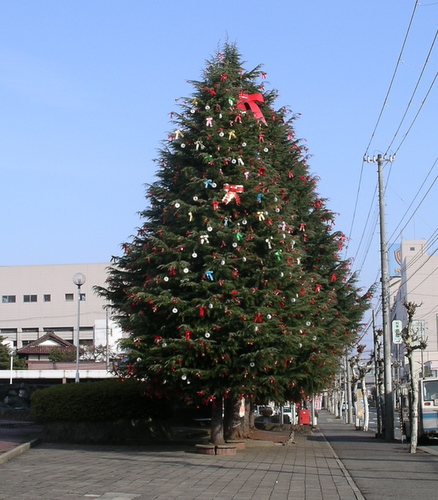 The trees in front of the Kitakami city office, all dressed up for Christmas. The name of the decoration scheme is "Ribbon Showers."
You Know You're In a Big City When. . .
. . . there's at least one giant TV mounted on a building downtown. 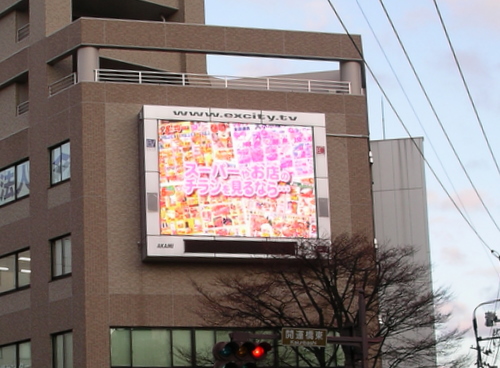 This is Morioka's giant TV. Kitakami, alas, isn't big enough for one.
Saturday, December 13, 2008, 2:39 AM GeneralPosted by stefanie The genkan, or entryway, serves an important purpose in Japanese buildings. It is much more of a transition zone between inside and outside than in most American homes. When we enter someone's home or an office building, we remove our shoes and coats in the genkan before we enter; similarly, when we leave we put our outerwear back on in the genkan. Except that putting my coat on in the entryway is the one custom I just can't get after a year and a half. We've put a lot of effort into learning many of the niceties of daily Japanese life and do a reasonable job of being polite members of society. So it's especially frustrating that something as basic as not wearing my coat all the way inside won't stick with me. Actually, it's more embarrassing than that: it wasn't until last week that it really sank in that wearing my coat inside was not daijoubu. And I had that unfortunate revelation as I was leaving a classroom at one of the companies where we teach, coat on. After that, it was like the Japanese etiquette mistake version of the walk of shame — walking quickly, kind of slinking, looking at absolutely no one as I went. Mortification still fresh in my mind, I returned to the company today for my regular class, firmly reminding myself that I would not put my coat on until I reached the genkan. Which I successfully managed to do, but only after wearing my coat most of the way to the classroom when I got there. Maybe I need to tie my coat to my shoes with string.
Although we've been here about a year and a half, Japanese packaged foods continue to surprise us. Last night, we made a bowl of ramen that we'd received at a community event a few weeks ago (community events in Japan always involve giveaways of household items). The picture on the package showed some garnishes like scallions, dried bamboo, and a thin slice of cow tongue. Tongue isn't a common ramen accompaniment. We assumed that it represented a serving suggestion and thought the inclusion of tongue kind of odd. The picture made sense, however, when we opened the package and found noodles, soup base, sauce, and a small package of dried garnishes that included . . . a thin slice of cow tongue.
[ add comment ] permalink
Tuesday, December 2, 2008, 8:40 AM GeneralPosted by matthew Just a quick note to let our readers know we won't be updating much for the next week or so; we should be back in full swing by mid-December, though!
[ add comment ] permalink
Tuesday, December 2, 2008, 2:12 AM GeneralPosted by matthew That Japanese people love karaoke is a stereotype, but it's a well-grounded one. Allowing that there are some who dislike karaoke, the vast majority of our friends enjoy it. Any group of people out having a good time is likely to end up in a karaoke bar or "box" (where you can rent a room for a private party with your friends).
It's hard not to get into the spirit when you're with a bunch of people unironically having fun singing shmoopy love ballads, TV show theme songs, and classic American or British rock songs. At first we chose songs from the (rather limited) selection available in English, but as we've been exposed to more and more Japanese music, we've branched out to sing our favorite Japanese songs, too.
It takes a lot of practice, but it's great fun. As an added bonus, it's not unusual to find examples of grammar we've recently studied. Of course, we learn new vocabulary, too, and get lots of reinforcement for the vocabulary of drama: tears, rain, new love, broken hearts, and fiery passion. Natural exposure is really important for gaining fluency, so karaoke is great for improving our language skills.
That's why we spent the afternoon studying The Blue Hearts, The Cro-magnons, Shonen Knife, Color Bottle, Thelma Aoyama, Kyu Sakamoto, and others.
[ add comment ] permalink
Sun-drying persimmons are a common sight around Japan in the fall. 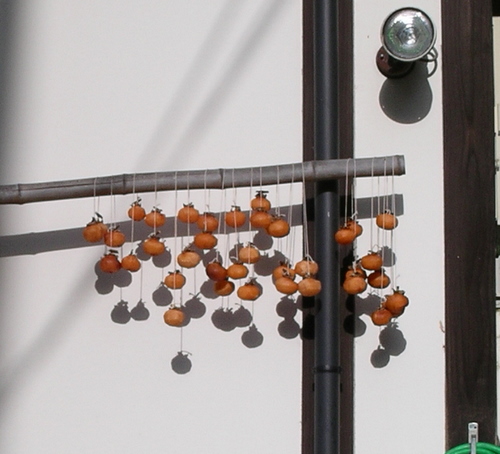 People hang the persimmons from a pole for a couple of weeks, until they shrivel and darken. They then store the dried persimmons, called hoshigaki, for snacking on during the winter.
If you ever need to buy soy sauce at the conbini, be sure to read the label first: 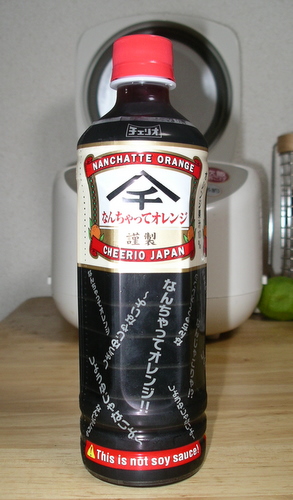 I love how emphatic the beverage is about not being soy sauce.
Winter has already arrived in Kitakami, which means it's time to start making nabe. Nabe is the Japanese word for cooking pot; the term is also applied to various one-pot dishes like soups, stews, or sukiyaki. One of our favorite nabe comes from Akita Prefecture: kiritanpo nabe.  Kiritanpo Kiritanpo is made by mashing cooked rice into a paste, then shaping the paste around a stick and grilling it. Because they get soft rather quickly, they're added to the nabe toward the end of cooking.  Chicken thigh, shirataki (noodles made of devil's tongue jelly), maitake mushrooms, carrots, and seri (Japanese parsley) rounded out the nabe. It was the perfect dish for a frigid, rainy night. กก
When you get damaged or misdirected mail in America, it usually arrives with some sort of brief explanation. Often, the explanation is an impersonal form with one of multiple preprinted reasons checked off (or the ever-popular "Other," with a terse, often illegible explanation). It might also say "We apologize for any inconvenience," or something like that. It's all very cold and official. Not so in Japan: 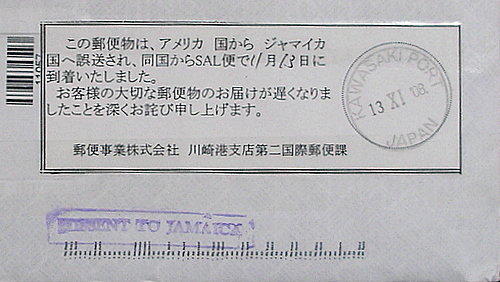 This came on a piece of mail we'd been expecting to arrive from America last month. It says, essentially: "This mail was sent from America to Jamaica, then arrived in Japan on November 13. The honorable customer's important mail was delivered late, and for that, we offer our deepest apologies." Interestingly, it seems that mail from America bound for Japan gets sent to Jamaica often enough to warrant preprinted labels with spaces to write in the date.
Back Next
|
|
 Calendar
Calendar




